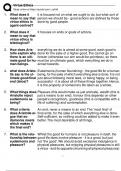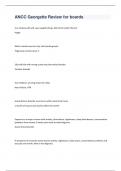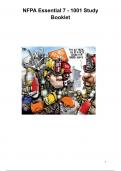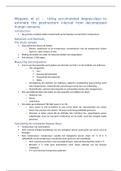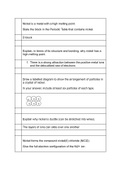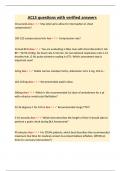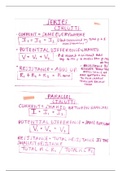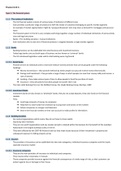Televisiestudies: samenvatting
Les 1: Inleiding en introductie tot televisiestudies
Quote Gray & Lotz: “Large square boxes around which we had organized our living rooms”
- Televisie in de woonkamer: woonkamers werden gerealiseerd rond tv (vandaag de dag nog
steeds maar minder belangrijk)
- Standaardisering in de filmindustrie: professionalisering, routine handelingen verlopen op
gestandaardiseerde manier
- Aanbod is zeer hard uitgebreid: andere manieren om aanbod te distribueren: klassieke +
streamingsdiensten
- Veranderingen: niet alleen in manier van consumptie maar ook in content à kwaliteitstv
- Nog steeds gelijkenissen vroeger en nu: samenkijken + multiple screenuse (gebruik op
kleinere schermen)
Leesteksten te bekijken:
1. Gray & Lotz: veld televisiestudies: introductie in veld doorheen geschiedenis
2. Kellner, D.
3. Andrejevic, M.
Televisie:
Geen entiteit (= veranderlijk, nt vast)
– (politiek-)economisch, technologisch, sociaal, psychologisch, cultureel, esthetisch
Maar een ‘site’
– The point at which numerous issues and processes intersect and inflect one another (Wasko,
2009) = wisselwerking tss factoren
– A switchboard through which streams of information, power and control flow unevenly
(Wasko, 2009) = onevenwicht van flows van informatie (vb. macht)
Televisiestudies = multidisciplinair veld: enkele specifieke kenmerken
- Combinatie mediastudies en humanities: sociaal constructivistisch perspectief
- Manier van analyse televisiecontent op dezelfde manier uit screen of filmstudies
Er werden voorspellingen gemaakt wat televisie in de tijd zou doen
(deels uitgekomen maar nog veel niet)
1948:
1950: In de jaren 2000: 3D kleuren tv op de muur … met ‘smellovision’, radio verdwenen, wireless,
draagbare telefoons, mét video
Jaren 1980: globalisering/amerikanisering
2006/2010: obsessie veranderingen in technologie, interactiviteit, ‘end of television’
Gaat over cultuur van televisie:
‒ Niet langer het enige scherm binnenshuis waarop mensen bewegende beelden ontvangen
‒ Van consumers naar ‘prosumers’ (= zelf creëren)
‒ Gebruiksvriendelijker dan ooit
, ‒ Toekomst: video even natuurlijk als schrijven (manier hoe we vertellen in beelden), VR (zeer
actueel: meer ingang vinden als volwaardige tvcontent à nu nog niet), esthetiek van Yt, Fb,
Insta,…
Veranderingen lopen niet zo’n vaart:
Oppassen met technologisch determinisme:
‒ Economische en sociale motieven
‒ Lessen uit het verleden
1. Eerste factor: the first law of technology
‒ Overschatting en onderschatting
‒ “Video did not kill the radio star” (= komst van muziekvideoclip, medium radio nt
verdwenen)
‒ Aanpassing (= beschouwen als onderdeel nieuwe media)
Tv industrie bevindt zich in crisis? à nt echt (golden age: veel content gemaakt en bekeken vs nt in
golden age: illusie)
2. Tweede factor: economische factoren
‒ Beperkingen
3. Derde factor: de complexiteit van individuen
‒ Consument is complexer dan het postmoderne beeld
‒ Sociale betekenis televisiekijken
‒ Nieuwe tendensen vaak eerder bij jongere mediagebruikers
Actuele debatten
- VRT – Streamz – concurrentie streamingsdiensten tegen Americanisering (Disney+)
- 13 Reasons Why – meer zelfmoorden
- Breaking Bad – daling druggebruik
- Thuis – my debat spoorlopen
- Porno en Netfix CO2 uitstoot: televisiecontent is zeer CO2 uitstotend
,Les 2: Is er een toekomst voor de televisie-industrie? Een politiek-
economisch perspectief op televisie
Deel 1: Online televisie
Broadcasting (kabel, satelliet (1980s) en digitale TV (1990s)) à analoge manier à digitale manier
Online TV (Internet 2010s)
“Television’s ongoing change seems endless – from tubes, to transistors, to chips; from cathode ray
display, to plasma, to projection; from broadcast, to cable, to Internet streaming; from dial-up, to
remote control, to algorithmic recommendation; from mass audiences, to niche audiences, to
individuals.” (Uricchio, 2014:275)
= veranderingen van manier van transmissie, consumptie mediacontent, technologie op zich in
huiskamers, definitie van publiek (mass-audience naar gepersonaliseerde, op maat gemaakte
content van individuals)
Online TV:
- Ingang vanaf 2000: breedbandtechnologie, tablets, smartphones
- Cultuur van televisiekijken is veel verandert
- Veel =/= devices (in tegenstelling tot klassieke TV in living)
- “Services that facilitate the viewing of editorially selected audiovisual content through
internet-enabled devices” (Johnson, 2019:1)
= service/curreren van content, welke content past bij u, op maat maken
via internet
- Linear television of non-linear television (vb. Netflix)
- Device ecology divers = diverse manier om content te consumeren op =/= devices
- Vormen: content, services, frames, platforms,
• Content delivery networks (CDN) (= maken downloaden van content mogelijk vb. Apple TV),
• Internet protocol television (IPTV) (= private spelers via service-provider content aanbieden
vb. Netflix)
• Over-the-top (OTT) (= content en services w aangeboden via internet met vrije toegang vb.
VRT NU (vaak gratis))
Vormen van services:
‒ Viewing services
‒ Editorial services => curatable culture (maken selectie van content op maat)
‒ Closed services (anders dan bij sociale media vb. YT, gebruiker makkelijker content uploaden
à hier niet!)
‒ Internet-connected services (=> metadata) (belang van data)
= cord cutting = doorknippen van de kabel (bepaalde tussenspelers zijn niet meer
aanwezig door de komst van online spelers)
Verschil tussen online TV en platforms: vb. PF = YT
, Appisation (= content aangeboden door bepaalde apps)
Makkelijk toegankelijk, wijzen weg naar content, manier van distribueren
Dataficatie = draaien op viewer behavior data
2 trends in tvmarkt
- Crossmedialiteit = zelfde content/merk beschikbaar stellen op verschillende dragers/vormen
Vb. Televise en internet online
- Convergentie = groeien van verschillende vormen naar elkaar toe = mengvorm
Vb. Internet en Tv = Web TV
(vaak gestuurd door economische veranderingen, overnames)
Rol van PSM
Commerciële en publieke omroepen bieden televisiecontent aan
PSB à PSM (= Public Service Broadcasting à Public Service Media)
Vragen rond distributie (vb. Digital-only content, maximise presence online)
Multi-platform strategie
Vragen rond universaliteit, inclusive, burgerschap, informatie, educatie
Interactie en participatie
Ook op Europees vlak à rapport: bezig met jeugd die minder weg vindt in PSM
Actueel: tijdens covid-19: mensen vinden weg naar PSM
“The entertainment industry soffers from “pervasive uncertainty” about how to include the online audience in
its operations and has been “unsuccessfull in imposing traditional business models on the internet.” It is far
from certain that the incumbent players will eliminate competition from innovators, maintain profit margins, or
continue grow. The industry faces growing competition in production and distribution of content. This
threatens to erode the artificial scarcity which lies at the foundation of media economics. Increased competition
is raising content costs and content producers are innovating with new business models such as crowdsourcing.
Each of these trends could change the economics of the television and movie industry and disrupt traditional
business models.” (Strangelove, 2015: 175)
Deel 2: Politiek-economisch pespectief op televisie
Audiences/het publiek
- Gesegmenteerd begrip
- Sociale constructie
- Geconstrueerd door aantal factoren:
o Structurele factoren (publiek dat voor ogen heeft)
o Motivationele factoren van een kijker (beschikbaarheid, bereidheid tot betalen,
kijkvolume)
o Contextfactoren (weer, week vs weekend, fysiologisch, vrienden/familie)
- Publiek is een massa (individu gaat op in massaconstructie)
- Binnen publiek: heterogeen, anoniem, weinig interactie, geen leiderschap
- Verschil doelpubliek vs daadwerkelijk publiek vb. Bronies (My little pony)
Onderzoeken over publiek:
(Passief publiek) Effectstudies: hypodermic needle, magic bullet theorie
à kijken naar onmiddellijk effect op gedrag/attitude, vaak negatief, lid van publiek reageert
hetzelfde, passieve kijker, vb. Bobo Doll Experiment (attitude en gedrag kan veranderen = effect
genereren, kinderen zien volwassene pop slaan, doen dit na)
‘Moral panics’: geweld, seksualiteit, body image, vaak na tragische gebeurtenissen
Les 1: Inleiding en introductie tot televisiestudies
Quote Gray & Lotz: “Large square boxes around which we had organized our living rooms”
- Televisie in de woonkamer: woonkamers werden gerealiseerd rond tv (vandaag de dag nog
steeds maar minder belangrijk)
- Standaardisering in de filmindustrie: professionalisering, routine handelingen verlopen op
gestandaardiseerde manier
- Aanbod is zeer hard uitgebreid: andere manieren om aanbod te distribueren: klassieke +
streamingsdiensten
- Veranderingen: niet alleen in manier van consumptie maar ook in content à kwaliteitstv
- Nog steeds gelijkenissen vroeger en nu: samenkijken + multiple screenuse (gebruik op
kleinere schermen)
Leesteksten te bekijken:
1. Gray & Lotz: veld televisiestudies: introductie in veld doorheen geschiedenis
2. Kellner, D.
3. Andrejevic, M.
Televisie:
Geen entiteit (= veranderlijk, nt vast)
– (politiek-)economisch, technologisch, sociaal, psychologisch, cultureel, esthetisch
Maar een ‘site’
– The point at which numerous issues and processes intersect and inflect one another (Wasko,
2009) = wisselwerking tss factoren
– A switchboard through which streams of information, power and control flow unevenly
(Wasko, 2009) = onevenwicht van flows van informatie (vb. macht)
Televisiestudies = multidisciplinair veld: enkele specifieke kenmerken
- Combinatie mediastudies en humanities: sociaal constructivistisch perspectief
- Manier van analyse televisiecontent op dezelfde manier uit screen of filmstudies
Er werden voorspellingen gemaakt wat televisie in de tijd zou doen
(deels uitgekomen maar nog veel niet)
1948:
1950: In de jaren 2000: 3D kleuren tv op de muur … met ‘smellovision’, radio verdwenen, wireless,
draagbare telefoons, mét video
Jaren 1980: globalisering/amerikanisering
2006/2010: obsessie veranderingen in technologie, interactiviteit, ‘end of television’
Gaat over cultuur van televisie:
‒ Niet langer het enige scherm binnenshuis waarop mensen bewegende beelden ontvangen
‒ Van consumers naar ‘prosumers’ (= zelf creëren)
‒ Gebruiksvriendelijker dan ooit
, ‒ Toekomst: video even natuurlijk als schrijven (manier hoe we vertellen in beelden), VR (zeer
actueel: meer ingang vinden als volwaardige tvcontent à nu nog niet), esthetiek van Yt, Fb,
Insta,…
Veranderingen lopen niet zo’n vaart:
Oppassen met technologisch determinisme:
‒ Economische en sociale motieven
‒ Lessen uit het verleden
1. Eerste factor: the first law of technology
‒ Overschatting en onderschatting
‒ “Video did not kill the radio star” (= komst van muziekvideoclip, medium radio nt
verdwenen)
‒ Aanpassing (= beschouwen als onderdeel nieuwe media)
Tv industrie bevindt zich in crisis? à nt echt (golden age: veel content gemaakt en bekeken vs nt in
golden age: illusie)
2. Tweede factor: economische factoren
‒ Beperkingen
3. Derde factor: de complexiteit van individuen
‒ Consument is complexer dan het postmoderne beeld
‒ Sociale betekenis televisiekijken
‒ Nieuwe tendensen vaak eerder bij jongere mediagebruikers
Actuele debatten
- VRT – Streamz – concurrentie streamingsdiensten tegen Americanisering (Disney+)
- 13 Reasons Why – meer zelfmoorden
- Breaking Bad – daling druggebruik
- Thuis – my debat spoorlopen
- Porno en Netfix CO2 uitstoot: televisiecontent is zeer CO2 uitstotend
,Les 2: Is er een toekomst voor de televisie-industrie? Een politiek-
economisch perspectief op televisie
Deel 1: Online televisie
Broadcasting (kabel, satelliet (1980s) en digitale TV (1990s)) à analoge manier à digitale manier
Online TV (Internet 2010s)
“Television’s ongoing change seems endless – from tubes, to transistors, to chips; from cathode ray
display, to plasma, to projection; from broadcast, to cable, to Internet streaming; from dial-up, to
remote control, to algorithmic recommendation; from mass audiences, to niche audiences, to
individuals.” (Uricchio, 2014:275)
= veranderingen van manier van transmissie, consumptie mediacontent, technologie op zich in
huiskamers, definitie van publiek (mass-audience naar gepersonaliseerde, op maat gemaakte
content van individuals)
Online TV:
- Ingang vanaf 2000: breedbandtechnologie, tablets, smartphones
- Cultuur van televisiekijken is veel verandert
- Veel =/= devices (in tegenstelling tot klassieke TV in living)
- “Services that facilitate the viewing of editorially selected audiovisual content through
internet-enabled devices” (Johnson, 2019:1)
= service/curreren van content, welke content past bij u, op maat maken
via internet
- Linear television of non-linear television (vb. Netflix)
- Device ecology divers = diverse manier om content te consumeren op =/= devices
- Vormen: content, services, frames, platforms,
• Content delivery networks (CDN) (= maken downloaden van content mogelijk vb. Apple TV),
• Internet protocol television (IPTV) (= private spelers via service-provider content aanbieden
vb. Netflix)
• Over-the-top (OTT) (= content en services w aangeboden via internet met vrije toegang vb.
VRT NU (vaak gratis))
Vormen van services:
‒ Viewing services
‒ Editorial services => curatable culture (maken selectie van content op maat)
‒ Closed services (anders dan bij sociale media vb. YT, gebruiker makkelijker content uploaden
à hier niet!)
‒ Internet-connected services (=> metadata) (belang van data)
= cord cutting = doorknippen van de kabel (bepaalde tussenspelers zijn niet meer
aanwezig door de komst van online spelers)
Verschil tussen online TV en platforms: vb. PF = YT
, Appisation (= content aangeboden door bepaalde apps)
Makkelijk toegankelijk, wijzen weg naar content, manier van distribueren
Dataficatie = draaien op viewer behavior data
2 trends in tvmarkt
- Crossmedialiteit = zelfde content/merk beschikbaar stellen op verschillende dragers/vormen
Vb. Televise en internet online
- Convergentie = groeien van verschillende vormen naar elkaar toe = mengvorm
Vb. Internet en Tv = Web TV
(vaak gestuurd door economische veranderingen, overnames)
Rol van PSM
Commerciële en publieke omroepen bieden televisiecontent aan
PSB à PSM (= Public Service Broadcasting à Public Service Media)
Vragen rond distributie (vb. Digital-only content, maximise presence online)
Multi-platform strategie
Vragen rond universaliteit, inclusive, burgerschap, informatie, educatie
Interactie en participatie
Ook op Europees vlak à rapport: bezig met jeugd die minder weg vindt in PSM
Actueel: tijdens covid-19: mensen vinden weg naar PSM
“The entertainment industry soffers from “pervasive uncertainty” about how to include the online audience in
its operations and has been “unsuccessfull in imposing traditional business models on the internet.” It is far
from certain that the incumbent players will eliminate competition from innovators, maintain profit margins, or
continue grow. The industry faces growing competition in production and distribution of content. This
threatens to erode the artificial scarcity which lies at the foundation of media economics. Increased competition
is raising content costs and content producers are innovating with new business models such as crowdsourcing.
Each of these trends could change the economics of the television and movie industry and disrupt traditional
business models.” (Strangelove, 2015: 175)
Deel 2: Politiek-economisch pespectief op televisie
Audiences/het publiek
- Gesegmenteerd begrip
- Sociale constructie
- Geconstrueerd door aantal factoren:
o Structurele factoren (publiek dat voor ogen heeft)
o Motivationele factoren van een kijker (beschikbaarheid, bereidheid tot betalen,
kijkvolume)
o Contextfactoren (weer, week vs weekend, fysiologisch, vrienden/familie)
- Publiek is een massa (individu gaat op in massaconstructie)
- Binnen publiek: heterogeen, anoniem, weinig interactie, geen leiderschap
- Verschil doelpubliek vs daadwerkelijk publiek vb. Bronies (My little pony)
Onderzoeken over publiek:
(Passief publiek) Effectstudies: hypodermic needle, magic bullet theorie
à kijken naar onmiddellijk effect op gedrag/attitude, vaak negatief, lid van publiek reageert
hetzelfde, passieve kijker, vb. Bobo Doll Experiment (attitude en gedrag kan veranderen = effect
genereren, kinderen zien volwassene pop slaan, doen dit na)
‘Moral panics’: geweld, seksualiteit, body image, vaak na tragische gebeurtenissen

